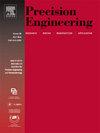探讨不同振幅下超声振动辅助加工SiCp/Al复合材料的表面/地下形成机理
IF 3.5
2区 工程技术
Q2 ENGINEERING, MANUFACTURING
Precision Engineering-Journal of the International Societies for Precision Engineering and Nanotechnology
Pub Date : 2025-05-23
DOI:10.1016/j.precisioneng.2025.05.021
引用次数: 0
摘要
由于SiC颗粒和Al基体的去除机制存在显著差异,提高SiCp/Al复合材料的加工质量面临着重大挑战。超声振动辅助加工(UVAM)是提高SiCp/Al复合材料可加工性的一种有吸引力的解决方案。然而,不同振幅对地表/地下形成机制的影响尚未得到系统研究。在本研究中,通过一系列的加工和测试实验,深入研究了不同超声振动幅值下的切削力、表面质量、亚表面损伤(SSD)和显微组织变形的演变。随着超声振动幅值的增大,切削力的减小比例增大,切削力的减小主要来源于Al基体。超声振动作用下表面粗糙度的变化受SiC颗粒去除模式的改变所控制,合理的超声振动幅值有利于颗粒破碎而不是断裂。此外,固态切削的发生取决于切削力和刀具高频振动的共同作用。值得强调的是,较小的切削力可能并不意味着预期的表面/次表面改善。超声振动幅值为5 μm时,表面粗糙度最小,SSD深度最小。最后,残余拉伸应力出现在SiC颗粒中,Al基体晶粒细化。该研究有助于在制造过程中合理选择超声振动幅值,从而提高SiCp/Al复合材料的应用潜力。本文章由计算机程序翻译,如有差异,请以英文原文为准。
Towards understanding the surface/subsurface formation mechanism of ultrasonic vibration assisted machining of SiCp/Al composites under different amplitudes
Improving the processing quality of SiCp/Al composites faces significant challenges owing to the pronounced differences in the removal mechanisms of the SiC particles and the Al matrix. Ultrasonic vibration assisted machining (UVAM) is an attractive solution for upgrading the machinability of SiCp/Al composites. However, the impact of different amplitudes on the surface/subsurface formation mechanism has not been systematically investigated. In this study, the evolution of cutting force, surface quality, subsurface damage (SSD) and microstructural deformation under different ultrasonic vibration amplitudes was thoroughly investigated by a series of machining and testing experiments. The reduction proportion of the cutting force is enhanced with the growth of ultrasonic vibration amplitude, and the decrease in cutting force primarily derives from the Al matrix. The variation of surface roughness is governed by the alteration of SiC particle removal pattern under ultrasonic vibration, and a reasonable ultrasonic vibration amplitude facilitates particle fragments rather than fracture. Additionally, the occurrence of SSD depends on the collective effect of the cutting force and the high frequency vibration of the tool. It is worth emphasizing that the small cutting force may not imply the expected surface/subsurface improvement. The minimal surface roughness and SSD depth are achieved when the ultrasonic vibration amplitude is 5 μm. Finally, the residual tensile stress occurs in SiC particles and the grain refinement of Al matrix is observed. This study contributes to the rational selection of ultrasonic vibration amplitude in manufacturing so as to enhance the potential applications of SiCp/Al composites.
求助全文
通过发布文献求助,成功后即可免费获取论文全文。
去求助
来源期刊
CiteScore
7.40
自引率
5.60%
发文量
177
审稿时长
46 days
期刊介绍:
Precision Engineering - Journal of the International Societies for Precision Engineering and Nanotechnology is devoted to the multidisciplinary study and practice of high accuracy engineering, metrology, and manufacturing. The journal takes an integrated approach to all subjects related to research, design, manufacture, performance validation, and application of high precision machines, instruments, and components, including fundamental and applied research and development in manufacturing processes, fabrication technology, and advanced measurement science. The scope includes precision-engineered systems and supporting metrology over the full range of length scales, from atom-based nanotechnology and advanced lithographic technology to large-scale systems, including optical and radio telescopes and macrometrology.

 求助内容:
求助内容: 应助结果提醒方式:
应助结果提醒方式:


